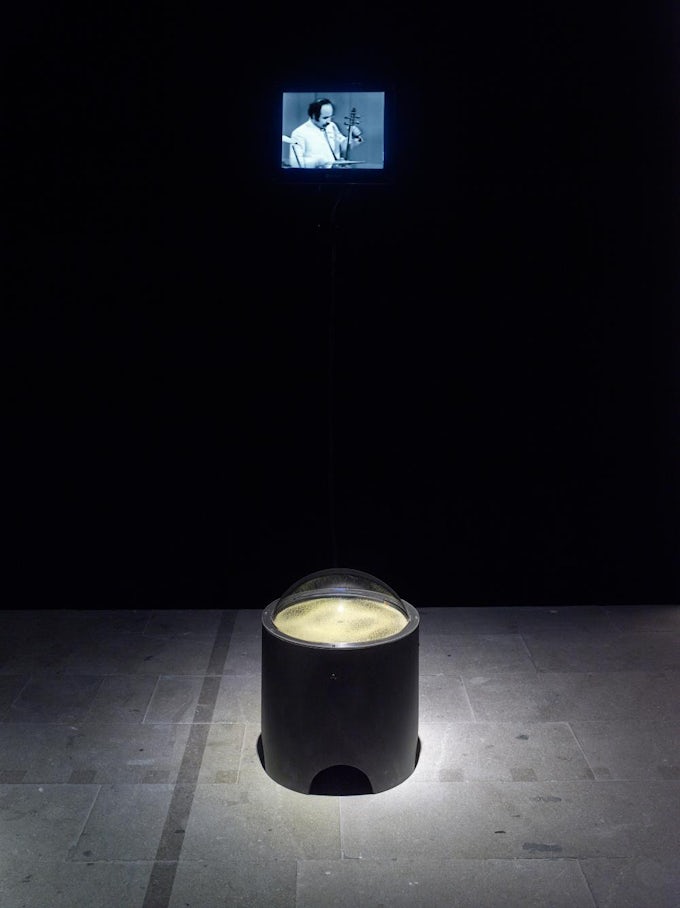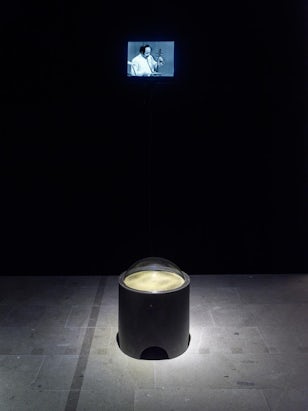
The Power of the Voice
Kader Attia’s video Prosody (2017)references the way in which the written text arouses emotions. The notion of prosody, originally related to classical metrics, designates the study of a specific verse, its accentuation and the quantity and quality of phonetic units. In its contemporary usage, it also refers to the modulation of the voice’s duration, rhythm and intensity. Its meaning encompasses the fields of linguistics, musicology, poetry and psychology, as it concerns the ability to communicate emotions. From early childhood, human beings express their eagerness for company and attention: prosody is what allows a new-born child to connect to their main care giver –typically the mother – and to express hopes, needs or feelings, therefore making life meaningful. With the development of language, the prosodic rhythm of the voice becomes crucial for storytelling, and more broadly, in how we interact with each other. It contributes in giving a particular meaning, via musical or acoustic effects or techniques, to a piece of writing, most notably, in poetry. Prosody concerns the entwinement of language and the body, not only because the way we speak to each other tells a lot more than what we actually say, but also because every piece of writing comes to life through the voice, and thus the body.
Prosody centres around the work of Moroccan poet Rachida Madani, 01 and features three women reading Madani’s verses: the poet herself, filmed in Tangiers where she lives, with Pascale Ourbih who is a transgender woman and activist living between Algiers and Paris, and Algerian singer, dancer and actress Biyouna. The video focusses on their emotional responses to the text, especially those of Ourbih and Biyouna who, unlike Madani, are filmed in private settings, possibly at their homes. The camera approaches their faces in a way that conveys the intimacy of reading and listening, while one of the verses read by Biyouna suggests: ‘The ear which hears me / does it know that it must bend over my mouth?’ The meaning of the text resides precisely in its ability to connect the speaker to the listeners, as the voice and the verse come together against the primacy of language as the sole bearer of meaning. Because it is more directly connected to the field of emotions, the voice organises the text as much as it disorganises language’s claim to control meaning.02
Prosody is part of a larger installation presented at the 57th Venice Biennale in 2017, entitled Narrative Vibrations (2017), which Attia describes as a journey through the form and meaning of sound. This tripartite work explores possible visual and sculptural materialisations of sound. The visitor enters the installation through a narrow corridor comprising an assemblage of archival materials, books, collages, drawings and video interviews retracing Attia’s research into the fields of acoustics and sound transmission, as well as music and ethnology. The main focus of the work concerns the socio-cultural dimension of sound in its political and emotional resonances: the central room presents a series of circular plates containing semolina, each connected to a monitor alternately broadcasting filmed recordings of Arabic postcolonial golden age divas. As the music starts, the semolina begins to vibrate and, as if literally moved by the singer’s voice, draws a series of patterns and forms on the plates. The artist indicates that he chose these specific songs because they made up a familiar soundtrack during his childhood031. The history of Arabic music in a time of decolonisation is thus viewed via a double perspective connecting the personal sphere to the role of the female singer in producing meaning in a transformative historical moment. The emphasis on the female voice also inevitably points to the question of prosody (the voice of the mother) and the eponymous video presented in the adjacent space. In Scheherazade’s story, 04 as told by Madani, the acoustic pleasure prompted by a woman’s ability to connect to her listeners has a subversive function and becomes a strategy of survival against male violence. The voice becomes a tool of resistance and struggle that, in the context of Narrative Vibrations, connects this work to Attia’s interest in the history of anti-colonial struggles.
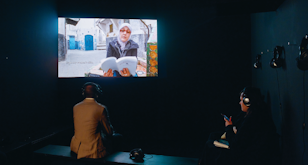
In and Out of the Colony
Kader Attia’s work has been mainly concerned with the slow temporality of the reparation, be it of collective traumas or of bodily injuries, and less concerned with the staging of more conflictual gestures of destruction and repair. Perhaps because it alludes to a history in the making, the performative installation Arab Spring (2014) seems to shift the focus from the object to the expressive gesture, as objects here are significantly absent. The work deals with the failure of the Arab Revolutions of 2011–12 through a symbolic restaging of the looting of the Egyptian Museum, located in Tahrir Square in Cairo. When the protesters entered the museum, display cases were destroyed and robbed of their content. As a response to this event, the museum decided to exhibit the broken and emptied vitrines. In Arab Spring, Attia replicates the museum’s old-fashioned display vitrines and on the occasion of each new presentation the artist stages a kind of re-enactment of the looting. Attia throws stones at the vitrines and destroys them again and again in an attempt to address both the revolution’s deceptive aftermath, as well as the transformative potential that had sustained it. As Clémentine Deliss has noted, this gesture attempts to rupture the colonial system of classification with its conventions of display and conservation.05 Attia’s perspective on the failed Arab Revolutions significantly locates the revolt in the space of the museum, thus pointing at the modern genealogy of knowledge within the field of art and culture. The artist’s apparently incoherent gesture is thus not just a performative commentary on the endless cycle of failed revolutions; it stages a far more composite act of reappropriation and repair, against the epistemic violence of the modern museum in its entanglement with colonial power. 06
The legacy of colonialism, and specifically French colonialism, is one of the main concerns in Attia’s body of work. In recent years his research and activity has unfolded in new directions, in an attempt to come to terms with the politics of fear prompted by the recent terrorist attacks in Paris and the drastic measures adopted by the French state. The 2015 attacks have accelerated Attia’s project to open La Colonie, an independent space located in northern Paris’s Gare du Nord area.07 As the emotions caused by the attacks were in the process of being translated into a set of repressive measures accompanied by rampant racism and Islamophobia, it seemed crucial to react to the trauma from a leftist postcolonial perspective, and La Colonie participated in this effort. The space is conceived as a sort of agora, a space for art, music, critical thinking, debate and cultural activism particularly focussing on the voices of minority groups, which are hardly heard in the mainstream Left, still attached to a form of paternalistic anti-racism that ultimately contributes to marginalising them. The space opened in the fall of 2016, a year after the devastating events, as an inclusive, transdisciplinary and transcultural place of discussion and knowledge production, proposing an experiment of social recomposition against the pernicious effects of both terrorist violence and state repression. As the opening statement explains: ‘Beyond religious and political divisions, our contemporary societies have reached a hitherto unprecedented level of fragmentation that only the development of spaces for dialogue, meetings and confrontations, will push back.’ 08
The opening of La Colonie has marked a significant shift in Paris’s cultural milieu, where the areas of art, activism and critical thinking tend to remain separate, and most importantly, where the political and artistic issues raised by minority groups are mostly overlooked or considered irrelevant. Whereas the French art world is still very attached to modernist notions such as art’s universal value and the (white, male) artist’s singularity and disinterestedness, in La Colonie art is considered in its entanglement with an array of social practices. Against a cultural milieu that is very hesitant to address its own entwinement with the politics of exclusion at play in French society, La Colonie’s programme aims at decolonising knowledge production while addressing issues of race, gender and power in the realm of art and culture. Recent events include, for example, ‘The White West. The Resurgence of Facism as a Cultural Force’, a conference addressing the entwinement of far-right idioms and visual communication, and ‘Black Lens’, a two-day seminar on how to build safe spaces in order to invent new forms of struggle and resistance across film, critical theory and art. Moreover, as the barring of the name indicates, La Colonie aims to explore the persistent legacy of colonialism in contemporary French society, pointing to the multiple regimes of exclusion at play within the boundaries of the République in an attempt to build a more inclusive and diverse community across the arts.
In the aftermath of the 2015 terrorist attacks, a powerful ideological apparatus was put in place alongside a number of repressive measures aiming to restrict individual and collective freedom. In this context, any position that would not fit into the framework of the national symbols and values of the French Republic – despite their structural link to colonial violence – was seen as divisive, or worse, complicit in Islamic terrorism. Whereas these values are relentlessly represented as universal, they have come to produce a notion of national belonging from which large sectors of French society are excluded. It should come as no surprise that the nation’s narrative of universalism and equality is, on the contrary, widely experienced as a system sustaining the widespread racism and discrimination against Muslims, migrants and more generally against the whole postcolonial population.
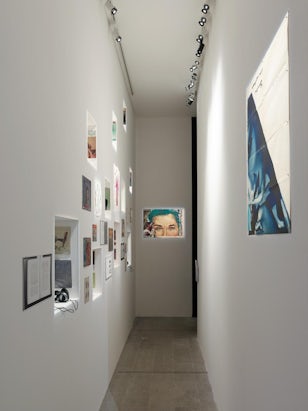
Within this context, it is particularly significant that La Colonie opened on 17 October, a date commemorating the 1961 massacre of hundreds of Algerians who were peacefully demonstrating in Paris in support of the National Liberation Front during the Algerian War. The number of deaths is still unclear as the state has denied responsibility for decades, despite evidence of men and women being beaten and intentionally drowned in the Seine river. Police officers who committed the crimes took orders from police chief Maurice Papon, who had previously collaborated with the Vichy regime during WWII, a fact that points to the continuum between fascist and colonial violence in French history. The choice of this date is a way to counter the official narrative presenting the République as the unique antidote to terrorism, proposing instead a more complex historical understanding of the current situation in light of France’s colonial legacy, which is still a controversial issue in public debates. Since its opening, a number of events and discussions at La Colonie, sometimes organised in tandem with research centres, were devoted to the historical excavation of the persistent colonial structures in contemporary French society: a scholarly conference addressed colonial prostitution in northern Africa from the mid-nineteenth century up to the 1960s; a one-week event in collaboration with the Cape Town-based collective Chimurenga examined the killing of Democratic Republic of the Congo President Laurent-Désiré Kabila in 2001; and an exhibition focussed on architecture and war in colonial Algeria.
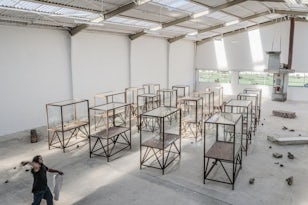
On Being Captured
Needless to say, one of the main consequences of the attacks was the establishment of a state of exception allowing for an increase in police repression specifically targeting the suburban population of African or Arab descent. Episodes of young men being injured or killed by police officers, particularly in the cities’ poorest suburban areas, have dramatically escalated in the years since, along with an unprecedented boost in the repression of any form of organised dissent, in and out of the suburbs.09 As it seems necessary to contextualise violence targeting racialised subjects in the specific context of the present alliance between neoliberal politics and state repression, it should not be forgotten that the daily violence experienced by France’s post-colonial communities finds its roots in a more complex and longer history going back to the exploitation of colonial territories and their populations.
Attia’s recent video The Body’s Legacies, Pt. 2: The Post-Colonial Body (2018) tackles the genealogy of police violence in postcolonial France, taking as its starting point the recent beating and rape of Théo Luhaka, a young man of African descent, during his arrest in Aulnay-sous-Bois in the northern suburbs of Paris in February 2017. This episode has caused widespread protests and uprisings across the country, especially as it happened a few weeks after the killing, in similar circumstances, of another black man, Adama Traoré.10 Demonstrations against police violence have proven their ability to initiate new forms of self-organisation and to empower a new postcolonial youth that will play a crucial role in the now more and more urgent recomposition of the Left. 11 These new political subjects are becoming increasingly vocal: in conjunction with the uprising prompted by these events, Parole d’honneur, an independent radio broadcast organised a number of public debates at La Colonie addressing police violence from the perspective of the postcolonial population living in the suburb’s poorest areas. These debates, which were widely attended, were crucial in Attia’s own undertaking of the subject.
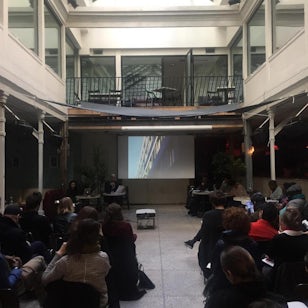
While the trial against police officers involved was still ongoing, in January 2018 a surveillance camera video was released showing the moment of Luhaka’s arrest.12 Attia’s video takes this footage as a starting point to question the ambivalent construction of evidence when issues of race and power are at play. Through the interventions of writer and cultural activist Olivier Marbœuf, journalist and decolonial activist Louisa Yousfi, philosopher Norman Ajari and theatre writer Amine Khaled, the video unpacks the debates prompted by the Luhaka affair while addressing issues of visibility and invisibility, postcolonial violence and the entanglement of individual experiences with collective emancipatory processes. As the footage of the arrest was released, right-wing politicians claimed that police officers were just trying to control a violent subject, and thus needed to be discharged from accusations. For others, on the contrary, the young man’s attempts to protect himself constitute evidence of police brutality. As the discussion in Attia’s video underlines, images never convey pure objectivity, but are inevitably entwined with what we have already seen or experienced in the past. For those who are victims of state violence, the footage reveals something familiar, because it is reminiscent of daily experiences and can be connected to a longer history. For others, the footage might just show a threatening individual that the police have to contain.
What emerges from these shifting interpretations is the persistent perception of the black body as an implicit danger, a question that Attia had already explored in his installation The Culture of Fear: An Invention of Evil (2013). This work presented a series of metallic shelves displaying a collection of images and publications (books, journals and newspapers) from the colonial era constructing the stereotypical image of the racialised other as a dangerous subject. In line with such historical representations, as Olivier Marboeuf explains in The Body’s Legacies, Pt. 2: The Post-Colonial Body (2018), the colonial power always tends to overestimate the black body in terms of its solidity, physical and sexual energy, while at the same time dismissing it when it comes to its singularity.
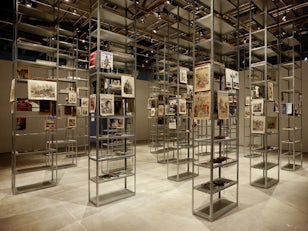
We must therefore keep this phantasmatic formation in mind while looking at the footage of Théo Luhaka’s assault. Indeed, what we see is already entwined with a racially saturated field of vision within which gestures of self-protection are transformed into acts of aggression, as if violence was the only deliberate act that a black body can perform. 13
In order to be able to think of Luhaka’s gestures in terms of self-defence, we may settle the scene within a larger genealogy of violence constructing the racialised body as a body that does not belong to itself and can therefore be captured. The slow motion indeed resonates with and reactivates an act of capture and thus of chattel, a sign of property: that of the slave body. The assault of a young black man by the police thus ultimately stages the relentless act of colonial appropriation defining our present. From the northern suburbs of Paris up to the hotspots across the boundaries of Europe, where refugees are captured and detained, the seizure and incarceration of racialised bodies sadly illustrates the enduring legacy of colonial violence. Whereas evidence can ultimately not always be provided with video footage, we need to be able to read visual representations as complex sites where historical forces are at play. The task of an emancipatory artistic practice could lie perhaps precisely in the attempt to excavate this complexity, not so much in order to provide definitive answers, but on the contrary, to expose the numerous layers of meaning in which our lives are increasingly entangled.
Footnotes
-
See Rachida Madani, Tales of a Severed Head (trans. Marilyn Hacker), Cambridge, MA: Yale University Press, 2012.
-
See Adriana Cavarero, For More than One Voice: Toward a Philosophy of Vocal Expression, (trans. Paul A. Kottman), Stanford: Stanford University Press, 2005, p.132.
-
K. Attia writes that these sound sculptures visualise the discoveries of German composer and physicist Ernst Chladni (1756–1827) of how some frequencies produce patterns that also exist in nature. See K. Attia, ‘Narrative Vibrations’, available at http://kaderattia.de/narrative-vibrations/ (last accessed on 6 May 2018).
-
Ibid.
-
Scheherazade, or Shahrazad, is a character and the storyteller in One Thousand and One Nights.
-
See Clémentine Deliss, ‘Kader Attia: The Phantom Limb in Art’, in Kader Attia: Reflecting Memory, San Gimignano: Galleria Continua, 2016.
-
On the concept of repair see Kitty Scott, ‘In Conversation: Kitty Scott and Kader Attia Discuss the Concept of Repair’, in Kader Attia, The Repair: From Occident to Extra-Occidental Cultures, Berlin: The Greenbox, 2014, pp.163–170.
-
La Colonie was opened on 17 October 2016. The official statement reads that the space is a place of Savoir-vivre and of Faire-savoir (an untranslatable wordplay implying notions of life and learning, meaning that La Colonie is both a place of conviviality and knowledge production) founded by K. Attia, Zico Selloum and their families. Statement available at http://www.lacolonie.paris/le-projet (last accessed on 11 May 2018).
-
Statement published on La Colonie’s website http://www.lacolonie.paris/le-projet (last accessed 29 May 2018).
-
Demonstrations against the new labour code (the so-called loi travail) voted under the presidency of François Hollande in 2016, mostly attended by a white urban population, were repressed by the police with unprecedented brutality. The same can be said about this year’s student protests and occupation of several universities across the country.
-
On 19 March 2017, a massive March for dignity and justice against police violence, promoted by the association of the families of the victims, gathered a number of organisations and activists struggling against everyday racism in France. The demonstration has marked a significant moment in France’s political landscape, despite the fact that no political force (including that from the Left) has been willing to take into consideration the demands coming from France’s postcolonial subjects during their concomitant campaigns for the 2017 elections. The official video calling for the march, featuring French rapper Kery James, activists and members of the victims’ families was filmed at La Colonie.
-
As historian Enzo Traverso has argued, such recomposition can only happen within a more general awakening of a postcolonial Left, able to counter the widespread racism and colonial legacy in contemporary French society. See Enzo Traverso, Les Nouveaux visages du fascisme, Paris: Textuel, 2017, pp.134–36.
-
On the whole episode see Samuel Earle, ‘Lords of Disorder’, Jacobin [online journal], 3 March 2017, available at https://www.jacobinmag.com/2017/03/national-front-theo-luhaka-police-protest (last accessed 10 May 2018).
-
Elsa Dorlin, Se défendre. Une philosophie de la violence, Paris: La Découverte, 2017, p.13.
